

CONCORDIA’S INDEPENDENT PUBLICATION SINCE 1980

























Julia Cieri

@_juliacieri
On Sept. 15, the Concordia Armenian Students' Union (CASU) sent an appeal to Concordia University’s President and others, urging them to reconsider sending delegates to Baku, Azerbaijan for the 29th session of the United Nations’ (UN) Conference of the Parties (COP29).
The university sent out emails to students and faculty in select departments, offering them the opportunity to sign-up for the in-person or virtual delegation.
Azerbaijan has been accused of ethnic-cleansing by Armenia. The country filed a case with the International Court of Justice in 2021, contending that Azerbaijan has
been subjecting Armenians in the contested Nagorno-Karabakh territory to “systemic discrimination, mass killings, torture and other abuse.”
In 2023, multiple international organizations have expressed alarm regarding the humanitarian situation in Azerbaijan following the country’s blockade of the Lachin corridor connecting Nagorno-Karabakh to Armenia, stopping all humanitarian goods transport.
CASU’s vice-president external, Matthew Doramajian, believes the country is hosting COP29 as a method of greenwashing. “The hope for Azerbaijan is that, by hosting this kind of prestigious event, they can get people to look at their cause with more sympathy and have a better opinion [of] Azerbai-
jan,” said Doramajian.
The UN has opted to hold the climate conference in Azerbaijan due to the country’s claimed commitment to “developing its renewable energy potential.” According to the International Trade Administration, oil and gas production is the anchor of Azerbaijan economy, with the fossil fuels accounting for around 47.8 per cent of the country’s gross domestic product in 2022.
CASU is not alone in their concerns. Armenian activists and Concordia alumni, Yon Nersessian, in partnership with his sister, Maria Nersessian, created a petition to protest the university’s decision to send delegates to COP29. “This is unacceptable and the fact that university is supposed to represent a lot

of Armenian students […] it’s insulting,” said Yon Nersessian.
Maria Nersessian hopes the petition makes Concordia reevaluate their stance. “We want them to withdraw their participation and be aware of what it means to be participating in such an event,” she said.
Doramajian feels similarly, as someone who considers Concordia students and faculty to be part of his community. “We feel that it is our responsibility to educate them where it is necessary for their own safety and for righteousness,” Doramajian said.
Concordia University spokesperson, Vannina Maestracci, said that one or two students and faculty
Queer Concordia is looking to create a short-term, interest-free loan pilot project to help students relieve the financial burden associated with paying for gender-affirming care (GAC) procedures.
The group will present the plan to the Concordia Student Union’s (CSU) Council of Representatives on Sept. 18. Queer Concordia will ask the union to allocate $100,000 annually to the project, which students under the CSU’s insurance can access as an interest-free loan.
The CSU’s insurance provider, Studentcare, currently only covers $5,000 per procedure and a $10,000 lifetime maximum for GAC surgeries and treatments not otherwise covered by the student’s provincial government coverage.
GAC procedures can often exceed $5,000—even $10,000—per treatment. The pilot project proposal outlines the cost of one student’s surgeries that added up to a total of $33,000. Queer Concordia senior coordinator Jessica Winton said that the project’s loans would allow students to access the care they are paying for.
“When a surgery is $10,000 or more, [...] sitting around for up to a month waiting to be reimbursed by insurance for $10,000 can leave a very large hole in your pocket and very easily put you into debt,” Winton said.
If the CSU approves Queer Concordia’s proposal, the $100,000 would cover about 10 students at maximum per year.
Studentcare also requires that students receive a letter from a legally qualified physician or nurse practitioner confirming a gender dysphoria diagnosis to be eligible for GAC coverage.
This goes against the recommendations of the World Professional Association for Transgender Health (WPATH) which state that “the use of rigid assessment tools for ‘transition readiness’ may reduce access to care,” and that a gender incongruence diagnosis “may better capture the fullness of gender diversity experiences and related clinical gender need.”
Adam Philomena is the Centre for Gender Advocacy’s community engagement coordinator. He be-
lieves that the insurance providers should follow WPATH recommendations and that healthcare providers should trust that patients seeking GAC have the most knowledge of their own bodies and identities.
“The requirement of a gender dysphoria diagnosis is a huge barrier for a lot of people because [...] people express their transness in different ways and may not be necessarily looking for that to be medicalized in a specific way,” they said.
According to the CSU website, there is currently no pay-direct coverage available for the GAC plan, meaning that students seeking care must pay for the procedure out-of-pocket before making a claim for reimbursement.
Winton believes the pilot project, if implemented, could help relieve financial pressure for trans and gender-diverse students.
“This will actually help people use the insurance,” Winton said. “Many people are put off from trying to use it because of the current restrictions of the $5,000 limit and the fact that you usually have to pay out-of-pocket.”
The CSU’s Health and Dental Plan expanded to include gender affirming care in 2023. Undergraduate students that are paying provincial or out-of-province tuition rates and are enrolled in three or more credits are automatically signed-up for the plan that costs $225 for full-year coverage.
CSU finance coordinator Souad El Ferjani, said that she would be open to the project, but that Queer Concordia is asking for a substantial amount of money.
“Me and my team would be sitting down trying to see how we can solve this, how we can accommodate everybody without putting our budget in a bad position,” El Ferjani said.
Philomena claimed that, despite fee-levy employees having the same CSU Health and Dental plan as undergraduate students, they do not receive the Studentcare GAC coverage as they do not have student identification numbers. The CSU failed to verify the claim despite The Link’s attempt for clarification.
Quebec residents insured with the Régie de l’assurance maladie
members at the university attend COP each year.
“We believe we are fortunate to have observer status with the United Nations Framework Convention on Climate Change (UNFCCC) which allows faculty and students to attend the primary global forum that addresses climate change,” Maestracci said.
Maestracci added that Concordia is not responsible for choosing the country hosting the climate conference. “Our association is with the [UNFCCC],” said Maestracci. “The UNFCCC chooses the host-country for their annual COP meetings.”

Geneviève Sylvestre

@gen.sylvestre
du Québec (RAMQ) can qualify for certain GAC surgeries and treatments, such as phalloplasties, vaginoplasties and mastectomies, if a doctor determines they are necessary. Other treatments, such as breast augmentations and facial feminization surgeries, are not covered by RAMQ as the government deems them purely esthetic. Many universities across Canada, including McGill University, have the same GAC coverage as Concordia. Rachel Bainbridge-Sedivy, a member of the McGill Trans Patient Union, said that the coverage is currently inaccessible.
“It’s healthcare. It’s a human right. It's important for people to be able to access that,” Bainbridge-Sedivy said. “Gender affirming care is not cosmetic, it is medically necessary.”
Winton will present the project to the CSU on Sept. 18. He encourages students to voice their support for the pilot project.
“We're really hoping that we can mobilize together and get this through,” Winton said, “because it really will help so many people.”



“Historic anglo” status not required for healthcare
A Quebec Liberal Party motion passed at the National Assembly on Sept. 12 certifying that anglophone Quebecers will not have to prove their “historic” status to receive healthcare services in English. The motion to amend this requirement passed unanimously.
CUPEU strike suspended early
The Concordia University Professional Employees Union (CUPEU) suspended its ongoing strike on Sept. 12 after reaching an agreement with Concordia University. CUPEU began striking on Sept. 4 to contest the university’s hybrid work plan in place for academic staff. A special general assembly for a ratification vote will take place this Wednesday, Sept. 18. All CUPEU staff members have returned to their regular work schedules.
ASFA revamps Investigative Committee
The Arts and Science Federation of Associations (ASFA) Investigative Committee is looking for members. The committee is tasked with upholding ASFA’s policy against harassment, discrimination and violence as well as investigating student complaints. Unlike previous years, this year’s committee will be composed of students who are not current or previous executive members and chaired by a coordinator who is not a Concordia student.
Concordia alleged to have removed BDS statements from faculty websites
According to the Geography Undergrad Student Society (GUSS), Concordia University has removed all statements in support of the Boycott, Divestment, Sanctions movement from faculty websites. On Sept. 14, GUSS uploaded a story on its Instagram account stating that these statements were removed without consent on Sept. 5.
Dexter Pahmer
Philippe Dubuc, a fashion designer for Sarah Pacini in Montreal’s Old Port, has watched the year’s most anticipated season pass him by. Ongoing construction on St. Paul St. W. significantly diminished access to his store, resulting in disappointing sales numbers.
“Of course there was a decrease,” Dubuc said. “We’re trying to be conciliatory, but there are strong financial disadvantages; it’s unpleasant."
Since the spring of 2024, pedestrians on St. Paul St. W. have been forced to move about on narrow walkways, wedged between shops and construction fences as they attempt to shop on Old Montreal’s foremost tourist street.
The road itself has been ripped open while construction workers operate on the aging water main, repair the sewer, and finally aim to rebuild the sidewalk and roadway. In addition to utility repairs, the project looks to render St. Paul St. W. more appealing to pedestrians by enlarging its sidewalks and removing parking on the street.
In Montreal, as summer blooms construction, it is also peak season for Old Port boutiques. As a result, many business owners have reported negative impacts from construction near their businesses.
Camille Albri, manager of Le Walk-In Montréal, a lifestyle and fashion accessory shop on St. Paul St. W., estimated that business has decreased “a good 35 to 45 per cent” due to the construction.
“We had no sidewalk. It was extremely noisy, so of course, far fewer people came,” Albri said.
Business is decreasing everywhere. Max Labé, an employee of Le Petit Duck Shoppe—a store selling a wide variety of rubber ducks—believes there are fewer people who want to walk on St. Paul St. W.
“The construction has led to very long lulls for businesses,” Labé said. “There’s absolutely no one in the store because of it.”
In the anticipatory phases of the project to redevelop St. Paul St. W., the city vowed to keep businesses open and accessible during construction, as well as maintain clear lines of communication with business owners.
“We’re doing one sidewalk at a time,” said Sébastien Breton, head of planning for the project. “If the side-
walk is done on the north side, then we’ll set up walkways so people still have access. There should be no problem when it comes to pedestrians.”
“It’s not always easy to walk about the construction,” said Émilie Thuillier, borough mayor of Ahuntsic-Cartierville, “but assuredly the businesses remain open; all the entrances are always open. If work needs to be done on these entrances, then it is done at night.”
Yet many say that, in practice, this was not the case. Albri explained that construction workers did not warn businesses before closing down their sidewalks.
“They put up a walkway, but it was still impossible to pass while they were pouring concrete,” Albri said. “It clearly wasn’t their priority. We had no idea what they were going to do on any given day. The only notices we got were when they cut off our water supply. For anything else, we arrive in the morning and we pray there isn’t too much noise, and that we can enter our business.”
Likewise, Labé said that no one from the site would warn business owners about forthcoming noise.
“If we open the door,” Labé said, “the noise is strident. It hurts. Often we’ll get headaches from it.”
“It’s a pain in the ass,” resident Christiane Berzi said. “There’s always something that pops up that [the city] wants to do, so it's like never-ending. We don’t see much results because everything is always under construction.”
Dubuc explained that there were several days when he had to close up shop because the store was basically impossible to access.
“The fences change depending on the work they’re doing. So sometimes it’s a bit more possible to walk around, but other times it's basically impossible to get anywhere,” he said. “It’s a labyrinth.”
When it comes to dealing with losses incurred by long-term construction work, the city has a compensation program that allows businesses to receive up to $40,000, provided the work lasts longer than six months and owners can prove a financial loss of 5 per cent or higher.
However, business owners must wait until the end of the construction to request the amount. If a business goes bankrupt while there is ongoing construction, it is not eligible for

compensation. The city also offers a lump sum of $5,000, which business owners can access immediately at the beginning of construction.
However, according to Dubuc, this sum is often not enough for independent store owners, who cannot necessarily lose a full season of business and remain solvent.
“A business might fail because of a construction site,” Thuillier said. “It’s not impossible, but it’s probably never the only reason. Sometimes the business is already doing quite poorly and perhaps the construction is the straw that breaks the camel’s back.”
Some business owners understand that these kinds of hardships are necessary in the long run.
“It has to be done,” Dubuc said. “But it's just sad that, as it’s happening, it has to be so difficult and cause the closure of so many businesses.”
Many have also complained that the compensation is not as accessible as it should be. The CBC reported that between 2019 and 2023 there were 419 claims submitted for compen sation, and only 189 were ap proved. Thuillier said this rate is not an indicator of the program’s efficiency, but rather because business owners often cannot provide the numbers proving a sufficient decrease in business.
Ahuntsic resident Has soun Habib believes Mont real’s current “construction blitz” is due to poor munici pal management.
“Montreal has deterior ated [at the expense of con struction]. It is no longer the way it used to be,” Habib said. “It’s an old city and it’s been neglected by previous municipal gov ernments.”
Per the city, due to low budgets and long-lasting unpopu larity, “maintenance work on Mont
real’s infrastructures was postponed, resulting in a maintenance deficit.” The intensity of the city’s current construction aims to compensate for this neglect.
The pressure of construction felt by businesses across the island also weighs on residents. Maham Nahim, a Montreal native, doesn’t remember a time when the city wasn’t under construction.
“I understand doing this to make Montreal a better place [...] but it’s just that it’s been that way for so many years,” Nahim said. “Sometimes you don’t need to change everything.”



Thousands participated in a weekend-long protest for more substantial housing rights in Quebec

@studiobonjourhi
The Front d’action populaire en réaménagement urbain (FRAPRU) organized a two-day series of events from Sept. 14 to 15 calling for the Quebec government to address the ongoing housing crisis by increasing social and community housing within the province.
FRAPRU aims to advocate for the right to housing, focusing specifically on funding for social housing projects and the regulation of the private housing market. The demonstrations are part of the organization’s “La clé, c’est le logement social” campaign.
The protest began on the evening of Sept. 14 with an encampment in Quebec City. Protesters had intended to camp at Parc de l'Amérique-Française before police threatened them with arrest despite the FRAPRU stating they had been in discussion with the city regarding the encampment.
According to the FRAPRU,
around 1,300 people attended the march which started at the Parc de l'Amérique-Française and ended on the grounds of the National Assembly of Québec.
Protesters lined the barricades with drawings of keys and threw keys into the fountain outside the parliament in protest.
“[The police officers] were quite aggressive in letting us know that if we dared to put up one tent that they would seize it, fine us, [and] arrest us,” said Citizen Action Committee of Verdun (CACV) representative Kay Lockyer.
The group relocated to the grounds of the National Assembly after police endorsed the move. At parliament, the Sûreté du Québec had already set up barricades, threatening protesters with arrest should they attempt to sleep on the premises.
Around 60 people slept on the
ground in front of the National Assembly, with some symbolically putting up tents. The group was surrounded by police presence, including several large police vans.
Protesters reported unease with the heavy surveillance by the police, but no arrests were made during the demonstration.
Catherine Lussier, a coordinator at FRAPRU, said that this police interference is indicative of the larger sentiment of the provincial government’s lack of willingness to hear the concerns of citizens. “It feels like they don’t want to hear the message,” said Lussier. “That’s why we pushed back and we are still here.”
On Sept. 15, housing committees across the province including those from Outaouais, Bas-Saint-Laurent, Québec-Chaudière-Appalaches, Saguenay-Lac-Saint-Jean, and Montréal
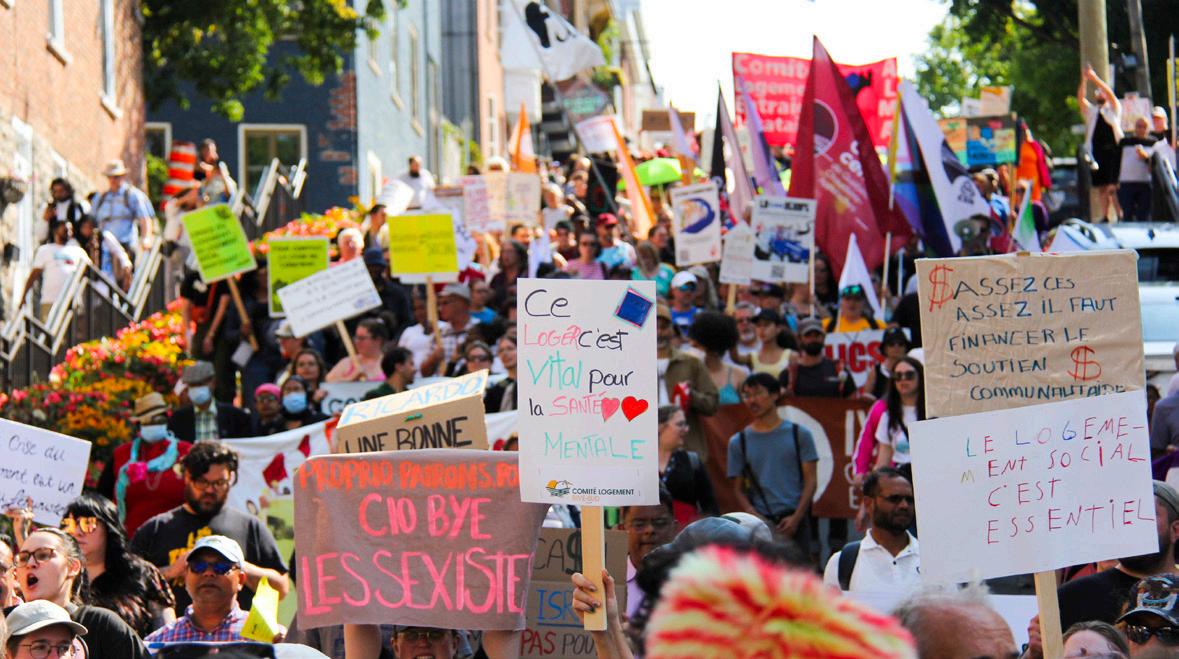
came to Quebec City to support the provincial action.
Labour unions, feminist organizations, and housing advocacy organizations participated in the protest to show solidarity with the movement.
“The fight for housing is a social issue but it is also a labour issue. An injustice faced by one person is an injustice to all,” said François Proulx-Duperré, a representative of the labour union Confédération des
syndicats nationaux. “The fight for unionism and for housing is interrelated, they are integrated, one into another. Count on us in your fight because it is also ours.”
“If we’re not investing in social housing, we are going to see more homelessness,” said CACV representative Lyn O’Donnell. “We’re all experiencing housing precarity. Everyone is talking about the housing crisis because everyone is living it.”

A nationwide set of annual anti-trans rights protests are set to take place on Sept. 20. Here’s what to know about this oppressive movement, and what is being done in Montreal to counter it.
What is ‘1 Million March 4 Children’?
Under the name “1 Million March 4 Children,” the anti-trans rights protests taking place throughout various Canadian cities on Sept. 20 seek to silence trans voices and prevent children from learning content within the Sexual Orientation and Gender Identity (SOGI) curriculum in Canadian schools.
Those involved with the movement have expressed that they believe the SOGI curriculum in Canadian schools is “adult-themed content” synonymous with sexual education classes, and is inappropriate for children to learn about. According to Montreal-based trans rights activist Celeste Trianon, this movement peaked in popularity at the height of the COVID-19 pandemic alongside the Freedom Convoy movement.
Over the years, these protests have been backed by far-right conspiracy theorists and anti-public education groups. One such group, known as “Hands Off Our Kids,” states in its
mission that it “refuses to stand by while the government and school system allow sexually explicit content and gender ideology to be distributed in our classrooms,” and that it strives for a school system “free from biases and indoctrination.”
“They’ve successfully fear-mongered a lot of concerned parents,” Trianon said about these far-right groups. According to her, several of these parents are not inherently transphobic but have been pressured into believing that the SOGI curriculum is harmful to their children. However, she added that the majority of those involved with the Million March 4 Children movement are people who have “absorbed anti-trans rhetoric” and now identify with it.
How is the Montreal community fighting back?
In retaliation for this year’s 1 Million March 4 Children protest in Montreal, queer and trans rights advocates like Trianon have been spreading the word about a counter-protest also taking place on Sept. 20. Faction
Anti Génocidaire et Solidaire—a queer collective focused on “denouncing Fierté Montréal’s pinkwashing” as stated on their website—is organizing this Montreal counter-protest.
Trianon said she is hopeful that
Hannah Scott-Talib

@hannah.sctt
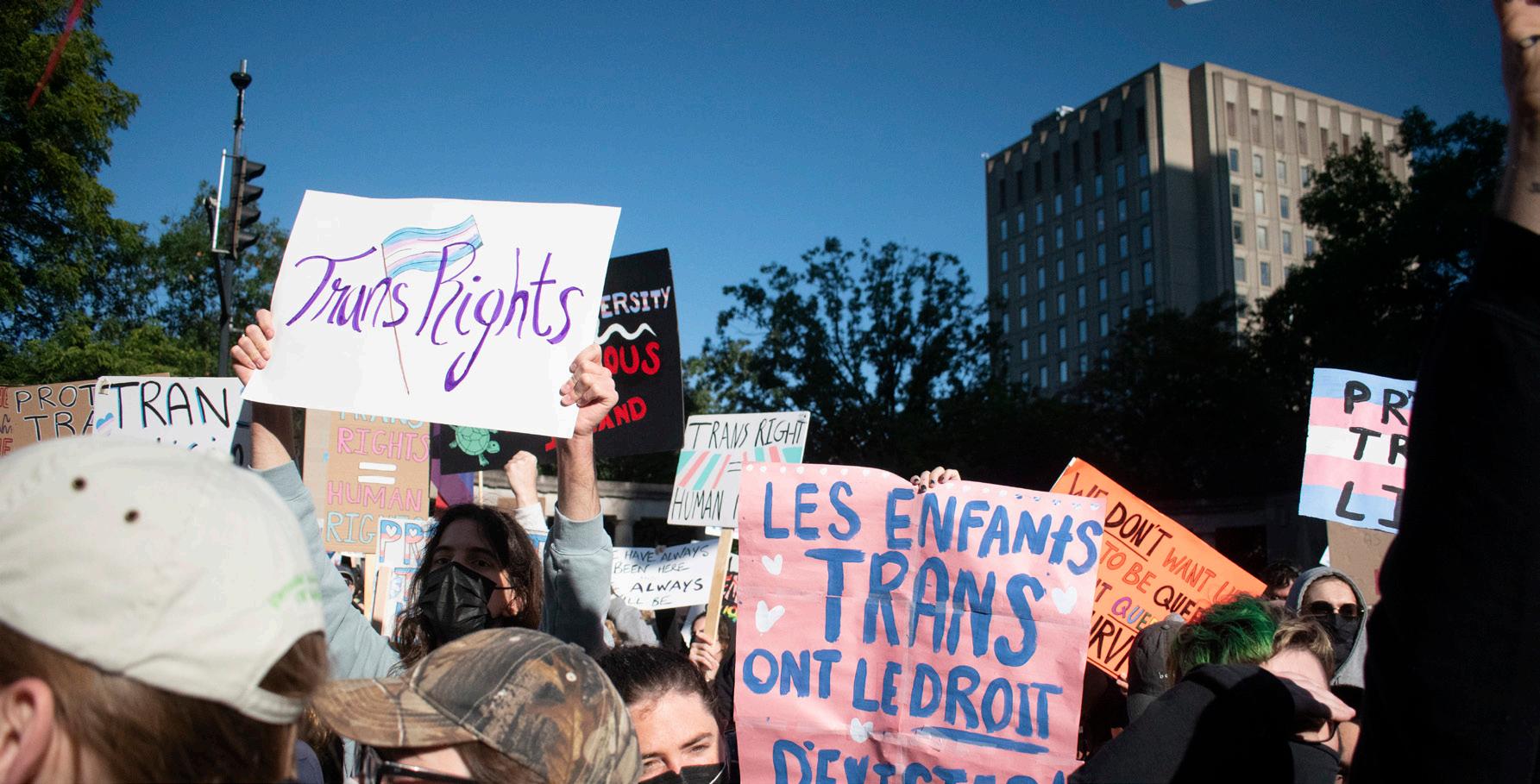
the turnout for this year’s counter-protest will be better than last year’s.
“Last year with the community, the response was unfortunately not sufficient,” she said. She added that most people in attendance didn’t know what to expect, and didn’t anticipate how many people would be part of the anti-trans movement. According to her, counter-protesters were significantly outnumbered by the anti-trans rights protesters. This year, however, she believes there is more of a sense of clarity and mobilization.
“Show up if you can,” Trianon said,
“and I’m speaking especially to all the people who call themselves allies.”
Attending the counter-protest on Sept. 20 is not the only way to support the queer community at large.
“[That protest] is not the only option, and I want to make that very clear,” Trianon said. “There are other ways to support queer and trans communities.”
Trianon said that an important way to provide support is to spread awareness through the sharing of knowledge on resources for the queer community. She also encouraged people to check
in on trans friends and family.
“Ask them if they’re doing okay, which is very important right now. A lot of trans folks are not doing okay,” Trianon said. “Be there for them.”
“The anti-trans hate machine runs on billions of dollars,” she said. Contrarily, Trianon added that many resources and facilities for the queer community have little to no funding.
“Go support a local organization and movement if you can,” she said.
The Protect Trans Kids counterprotest will begin at 8 a.m. on Sept. 20 at 275 Notre-Dame St. E.


Hannah Scott-Talib @hannah.sctt

There has been a steady rise in racism towards South Asian communities in Canada over the past couple of years, according to recent data published by Statistics Canada, and one of the main culprits might be social media.
This year, xenophobia can largely be traced down to anti-immigration rhetoric being spread in online comment sections without regulation, as well as Tik Tok trends that mock South Asian cultures.
“There’s so much normalized hate towards South Asian communities [in Canada],” said 19-year-old Bangladeshi Concordia student Afra Azreen, who moved to Montreal in 2022.
Dipti Gupta, professor of communications and film studies at Concordia University and Dawson College, said she believes that this racism stems largely from a lack of acceptance towards immigrants. It’s a sentiment that she said she has experienced herself throughout the past couple of decades living in Canada as an immigrant.
“I think people feel a sense of anger and fear in thinking that somebody is coming here and
not following a certain culture,” Gupta said. “They feel that somebody is less than [them], not realizing, at the end of the day, we all need to treat each other as human beings first.”
During the months of January, February, May and June 2024, Canadian immigration officials refused more visitor visa applications than they approved. The ratio of refused applications to approved ones was the highest recorded since the peak of the COVID-19 pandemic.
A recent poll from the Leger for Association of Canadian Studies revealed that, in cities such as Toronto, targeted racism towards Sikh Indian immigrants in particular has been on the rise this year.
Indians are currently the largest demographic of immigrants coming to Canada.
“There’s a lot of ‘Othering’ in general [towards South Asian immigrants],” Gupta said, referring to Edward Said’s notion of Orientalism. The phenomenon describes how Western culture intellectually holds itself above the East, or Asia.
“This ‘Othering’ has only accelerated in some ways, and has become more prominent,” Gupta said. “[It] stems from a fear that the ‘Other’ is not as educated, or
is less than [Westerners].”
According to Azreen, it’s not uncommon to find social media videos mocking South Asian culture in some way or another these days, particularly when it comes to videos of street food being made in countries like India.
“They’ll be [making] a cultural dish, and then people are hating on it in the comments,” Azreen said. “People are very quick and harsh to make these comments, it gets blown out of proportion and that wouldn’t have happened if it had been a different culture.”
“It tends to be [seen as] different, and usually it’s a bad type of different,” Ayaaz Esmail said on the topic of South Asian food. The 23-year-old grew up in Vancouver with Indian and Ugandan heritage. “It’s that fear of the unknown, and fear perpetuates hate, which makes people ignorant.”
Both Azreen and Esmail expressed that, throughout their lives, they have experienced being stereotyped as a result of their ethnicity.
“I’m generalized under a picture of people who hate women, or who hate gay people,” Esmail said.
As an Ismaili Muslim, Esmail said his identity gets mixed into stereotypes pertaining to people from certain Middle Eastern
countries, despite him having no relation to these countries.
“We’re rarely shown the really positive pictures of my faith, [or] of other people’s faith,” he said. “It really sucks because we’re all just generalized as brown.”
On her end, Azreen said she believes that gender plays an important role when it comes to stereotyping South Asians online. She said her experience as a woman differs from those of South Asian men.
“Gender does play a huge role, and it works in a way that’s kind of opposite to what you’d think,” Azreen said.
According to her, South Asian women fall on either side of the coin—either they are fetishized for qualities that are similar to Western beauty standards such as minimal body hair and white skin, or they are considered undesirable if their South Asian features stand out and are perceived as masculine.
“The more cultural someone looks, the more this hatred is there,” Azreen said, adding that she believes that brown women often have to go out of their way to prove their femininity when it comes to appearance.
On the other hand, she mentioned that South Asian men are almost always perceived as being

undesirable according to Western beauty standards. As an example, she stated that well-known TikTok accounts such as CityBoyJJ, known for doing street interviews in Canadian cities, reveal these harmful stereotypes to be prevalent.
“[The interviewers] go around and ask, ‘Which ethnicity would you not date?’ And it’s always South Asian,” Azreen said. She specified that, from what she sees, these answers are often given by white women about South Asian men.
In addition to the normalized appearance-based racism she’s noticed and experienced, Azreen said that videos of violent and destructive situations from her home country have recently surfaced online, leading to a rise in ignorant and hateful comments. Bangladesh is currently undergoing a revolution, and the online response to social media footage of buildings burning and collapsing as a result of the revolution left Azreen feeling afraid.
“It’s real footage from my country, and the comments were just making fun of it as if it wasn’t real,” she said, citing comments from the video that stated things like “average day in Bangladesh” or even “average day in India.”
But when it comes to social media, this type of reception is unsurprising to Gupta.
“We are all sucked into this kind of vortex of social media now,” Gupta said. “If [social media] is used in the best way, it can impact a lot of people. But does that happen all the time? A large cross-section of us believe that it is [solely] a mode of entertainment.”
In general, Canada has a reputation for being an immigrant-friendly country. But people like Gupta believe that with the all-too-common instances of racism and xenophobia that South Asians experience, this reputation might not be accurate.
“Despite all the efforts that we put into our system, into our policies, into our education and everything else,” Gupta said, “we’ve not been able to rise above this [racism].”


Perogie Lili offers more than
Claudia Beaudoin @claudiaclx

In the 1950s, in an apartment on Waverly St. in Montreal, Lili Lewyckyj, a Ukrainian mother, prepared meals for her four boys. Her goal was to offer them a taste of their distant home and culture.
Little did Lili know, she was leaving a deep and lasting impact on her youngest son, Nestor Lewyckyj. Her tradition of preparing classic Ukrainian meals would shape the Mile End neighbourhood long after her passing. This inspiration culminated in Perogie Lili, a new restaurant dedicated to sharing Ukrainian dumplings, known as ‘varenyky’ in Ukrainian, or more commonly, perogies.
Lewyckyj had long dreamed of opening a restaurant that would present Ukrainian cuisine in a fresh way to Montreal. It was only after seven years of planning and the onset of war in Ukraine in 2022 that his dream truly began to take shape. Alongside his business partner Gregory Bedek, who previously organized the last nine years of the Montreal Ukrainian Festival, Lewyckyj meticulously brought every detail of the restaurant to life, from the food and decor to the location itself—just a block down
from where he grew up.
“I wanted it to look like some Ukrainian grandmother's kitchen,” Lewyckyj said. “We want to give people that vibe, that they're coming back to something wholesome, something real.”
Perogie Lili opened its doors in August 2024, revealing a restaurant with multiple layers of significance. At its heart, it serves as a tribute to Lewyckyj’s mother, after whom it is named.
Lili was part of a wave of immigrants who fled Ukraine during the Second World War. She spent five years in a displacement camp in Germany, with immigration proving to be no easy feat. When the war ended, many like her were reluctant to return, fearful of what awaited them under Soviet occupation. With no place to truly call home, Lili boarded a ship to Halifax in December 1950, then took a train to Montreal, where she settled at just 19 years old.
Lili passed away in 2022.
Honouring the culture Lili passed down to her family, Perogie Lili serves recipes that taste as authentic as they are familiar to those of Ukrainian descent.

The cozy diner also highlights Ukrainian artistry, from the music playing in the background to its striking murals. The current art features work by Kur & Kul Arts, a Ukrainian couple known for their vibrant representations of Ukrainian culture. At Perogie Lili, they've created a mural that spans the seasons, blending traditional Ukrainian symbols like Easter eggs and carolling with Quebec icons such as apple trees in fall. The mural even includes a nod to Lewyckyj’s dog.
Lewyckyj plans to refresh the mural every six months to keep the restaurant dynamic and engaging; this is just one of the ways he aims to create a constant flow of change at Perogie Lili.
Another way is through the menu. While offering traditional Ukrainian flavours, he also plans to introduce new varieties of perogies regularly.
“My pinnacle would be to make a foie gras perogie,” Lewyckyj said with a laugh.
The restaurant is also actively involved in humanitarian aid efforts related to the war in Ukraine, with 2 per cent of their sales going to the Canada-Ukraine Foundation.
“The whole point is to create something real and also to advertise to people that Ukrainians are here. We're part of the community,” Lewyckyj said. “The war is still going on and the genocidal invasion by Russia is still real; there's still people dying.”
Lewyckyj notices that many young Ukrainians have embraced the restaurant as a meeting spot, and he already sees groups coming in to find a sense of community. Among the six employees are three Ukrainian refugees who have found their place at Perogie Lili.
Anna Semenova Kozak arrived in Montreal in 2022 as a refugee. She initially struggled to find employment in Quebec due to the language barrier. She spent her first year focusing on French language classes before finally coming across Perogie Lili.
“It helps me to connect to my own culture and also to discover more people,” Kozak said. “We have here a very vibrant mix of Canadians, immigrants [and] Ukrainians, so it's just delightful.”
The restaurant is the first of its


kind in Montreal. Customers have flocked to the restaurant, drawn by curiosity and radio buzz. Some even make the journey from as far as the West Island just to experience the Ukrainian dish.
For Helen Mourikis, a regular customer, Perogie Lili has become a weekly Saturday tradition. She was there on their Aug. 23 opening day and keeps returning.
“I look forward to it,” she said, noting that she often thinks about the food in the days leading up to Saturday.
“The best reaction that we have, which happens multiple times per shift, is people will come and they’ll get one option—maybe potatoes because that feels safe and familiar. And then they’ll eat it and be like ‘That was so good,’ and they’ll get another one or try something else,” said Hannah Kirijian, one of the Canadian workers. “I find [this] shows just how good the food is, that people are coming back in an hour to get more.”
Lewyckyj explains that, for many, the taste of perogies evokes their own pasts. It transcends time and space, transporting people
back to their childhood homes or homeland with a simple taste of soft dough and potato filling.
Perogie Lili’s logo features a woman holding a perogie close to her chest with a warm, inviting expression.
“Ukrainian culture in general has a very positive, warm kind of feeling,” Lewyckyj said. “Like our logo, it's a maternal kind of soft, something you would have at home.”
Lewyckyj is always deeply touched when clients tell him his perogies are as good as the ones their grandmothers or mothers make.
“I always say, you could not pay me a better compliment,” he said.
Amid the bustle of Fairmount Ave., Perogie Lili begins its story, grounded in a history far richer than its new look suggests. As Lewyckyj reflects on his mother’s legacy, he simply says, “I’d hope she’d be proud.”
With each perogie served, the restaurant not only honours Lili’s memory, but also continues a timeless tradition, bringing a piece of the past to the present with every taste.


Claudia Beaudoin

@claudiaclx
Disclaimer: This article mentions themes of binge eating.
There couldn’t be a greater contrast between technology and a physical book—but when these two worlds collide, you get a unique and compelling read.
Fanie Demeule’s novel Mukbang uses QR codes to enrich her storytelling, filled with references that resonate deeply with those who have grown up online.
Demeule is a Quebec author who writes in French, with some books translated into English. Her work often tackles contemporary issues such as body image, mental health, social pressures, intimacy and the impact of being online.
One of her latest novels, Mukbang, was published in 2021 and translated in 2022. Demeule introduces us to Kim Delorme, a young girl who is completely captivated by her computer. Delorme spends her childhood glued to a screen, slowly pulling away from the real world. It's a story that hits close to home for many of us who grew up in the digital age, feeling that same sense of isolation as we lost ourselves in the
realm of online videos and games.
The term mukbang originates from the Korean word ‘meokbang,’ with ‘meokda’ translating to eat and ‘bangsong’ meaning broadcast. Mukbangs are also widely associated with live-streamed videos where a host consumes large quantities of food while interacting with an online audience. This trend is particularly popular on YouTube and has been adopted by content creators around the world.
The QR codes are an added layer to the experience, pulling you back to random YouTube videos from 10 or 15 years ago—oddly specific, niche content from that era of the internet;making the story feel even more immersive.
Our main character eventually decides to start her own YouTube channel, beginning with vegan and health content. But when she notices the rising popularity of mukbang videos, she shifts her focus. What began as a hobby quickly spirals into something dangerous, and an online feud pushes her to the edge.
At times treading the line with the unhealthy, some content creators have been shown to gain excessive weight due to the recurring binge eating. Mukbang is all the more relevant today with the recent case
of Nikocado Avocado, a well-known figure in the mukbang industry. Avocado uploaded a video on Sept. 6 showing that he had secretly lost 113kg off-screen. His story closely resembles that of Delorme, but with a different ending than the journey Demeule carries us through.
Demeule’s writing is straightforward yet gripping, moving quickly enough to make Mukbang a book you can devour in one sitting. Despite being only 179 pages long, it’s packed with complexity. Every page is equally compelling and vivid with some unsettling content.
Along the way, we meet side characters who are just as multifaceted as the main character, and we witness each of their inner struggles. They also serve as a reminder of our own media consumption and limitations—often forgotten as we roam the web.
Demeule mixes surrealism with realism in a way that poses the question of what's real and what’s not. As you read, the line between the fantastical and the everyday starts to blur, leaving you wondering if the events could actually happen. Her storytelling keeps you on your toes, pushing you to rethink your perceptions and explore where reality ends and imagination begins.

Reading a story set in Montreal is always a real treat, and it's wonderful to dive into the works of local authors who deserve more recognition. Demeule is not just accessible and
engaging—she's a natural storyteller with the ability to make you crave both the food she describes and the story she tells.




Sept. 18 Sept. 19 Sept. 20 Sept. 22 Sept. 21
Fashion show at the McCord Museum as part of Montréal F.W. 2024.
MARRAKECH dance show at Agora de la Danse


African Nights Acoustic Cabaret from 9p.m.
Exposures Trans Film Festival at Espace Transmission
MARRAKECH dance show at Agora de la Danse

African Nights Acoustic Cabaret from 9p.m.
Exposures Trans Film Festival at Espace Transmission
MARRAKECH show at Agora de la Danse
Opening Night of SAKURA play at the Centaur theatre, 8p.m.
African Nights Acoustic Cabaret from 9p.m.
Exposures Trans Film Festival at Espace Transmission

African Nights Acoustic Cabaret from 9p.m.
Exposures Trans Film Festival at Espace Transmission



India Das-Brown @india.db


On a balmy Friday afternoon in Montreal’s Plateau, Rihab Essayh is tucked into the nook of a cosy, artist-run centre with white walls and creaking floors.
The centre, Ada X, is hosting Essayh as its first artist-in-residence this autumn, and while it is her first day in the space, Essayh fits right in. She sits with pink highlights in her hair, a purple-and-white checkered skirt and a baggy green sweater that says, “I AM OKAY.”
“It feels weird to do an interview this early [in the residency],” she says, glancing up from her laptop. “It’s still the beginning; I’m addressing what I want to do, possibly an event or more research, or experimental installation.”
Essayh, 32, was born in Morocco and raised in Montreal. Her art—a blend of installation, poetry and performance—is not just something she creates; it’s something she inhabits. Her work is deeply intertwined with her experiences and the communities that have shaped her.
“I work a lot on how to honour my community; [how to] honour my support system,” Essayh says. “My past work was literally a whole love letter to them.”
Essayh’s residency, The Evaporated Tears of Sand Roses, is a poetic exploration of grief and transformation, reflecting the shared experiences of the Southwest Asian and North African (SWANA) diaspora. The sand roses symbolize beauty born from desolation.
“It echoes how the stone, the sand rose, present in North Afri-
ca and the desert [...] is produced by this process of evaporation. It's the salt that can glue the minerals together,” Essayh says. “But it also echoes this aspect and process of grief among the SWANA community, a grief that we're all feeling right now in regards to [...] the genocide of Gaza. This is colonization at its peak, and also dehumanization.”
Essayh’s art has always centred themes of utopia, softness, femininity and care, even during her time at Concordia as an undergraduate a decade ago. Her work for The Evaporated Tears of Sand Roses started back in September 2023, but she has begun to question why she is even creating a utopia when her community is suffering so much.
“How do I even comprehend, or grasp, or be able to imagine this soft future when the present is so bleak?” she asks. “It feels obsolete at times, wanting to make something utopic, especially in such a bleak reality.”
The Link asked Essayh how she plans to reconcile radical softness with the grief surrounding her SWANA community.
“I don’t know,” she says. “That’s the purpose, I think, of the residency. I'm realizing that I love talking about community. I think I'm just shifting toward [...] making events for a specific community, because it needs to be for them, because it needs to be safe for them.”
For Essayh, making space for healing doesn’t negate the painful realities surrounding the SWANA community, but rather offers a necessary refuge.
“It's just understanding that you're in a room with people [who], without saying a word, understand you,” she says. “That feeling of com-

munal acknowledgement is quite powerful.”
Essayh explains that something like the sounds from Montreal’s annual international fireworks competition this summer, L'International des Feux Loto-Québec, may be traumatic to those who have survived war or genocide. Here, the importance of gentle, therapeutic spaces becomes clear.
“I need it, so I need to make it,” Essayh says. “I need to have these spaces for me.”
Somewhere between being seen and being embraced, in a place that is less cynical, less defensive, more nurturing and radically soft, Essayh envisions her art.
“I consider myself a very feminine person,” she says. “I view the world through that lens. [...] Showing a neutral view of the world is not neutral. I am not neutral. I'm full of this one field of experience.”
The Link spoke with Tyra Maria Trono, a Filipinx artist, cultural worker and curator. She is also the programming coordinator at Ada X, and is researching how cultural identification shapes a person's perception. Trono’s own work, like Essayh’s, explores how belonging to a diasporic community influences and redirects this process.
“[Essayh’s] work [centres] the themes of what's going on in the world, especially Palestine,” Trono says. “I felt like her work was driven.”
Trono’s colleague Chloë p.f. Lalonde is a multidisciplinary artist and cultural worker from Montreal, as well as the communications and social media coordinator at Ada X. Lalonde is interested in the experiences of inclusion and exclusion that emerge through art.
“I think [Essayh’s] work is something that is really needed and resonates a lot with the community right now,” Lalonde says. “I think it's a really needed place of sharing and coming together in the softness to process this grief.”
With her work, Essayh hopes to drive one thing home.
“There is one thing that is really important to me,” she says. “My work is in response to the genocide that is happening in Gaza. It's [...] very close to my heart and very jarring to see someone, people that look like me, being valued so little on a daily basis. Every work that I've made this year shifted because of that.”
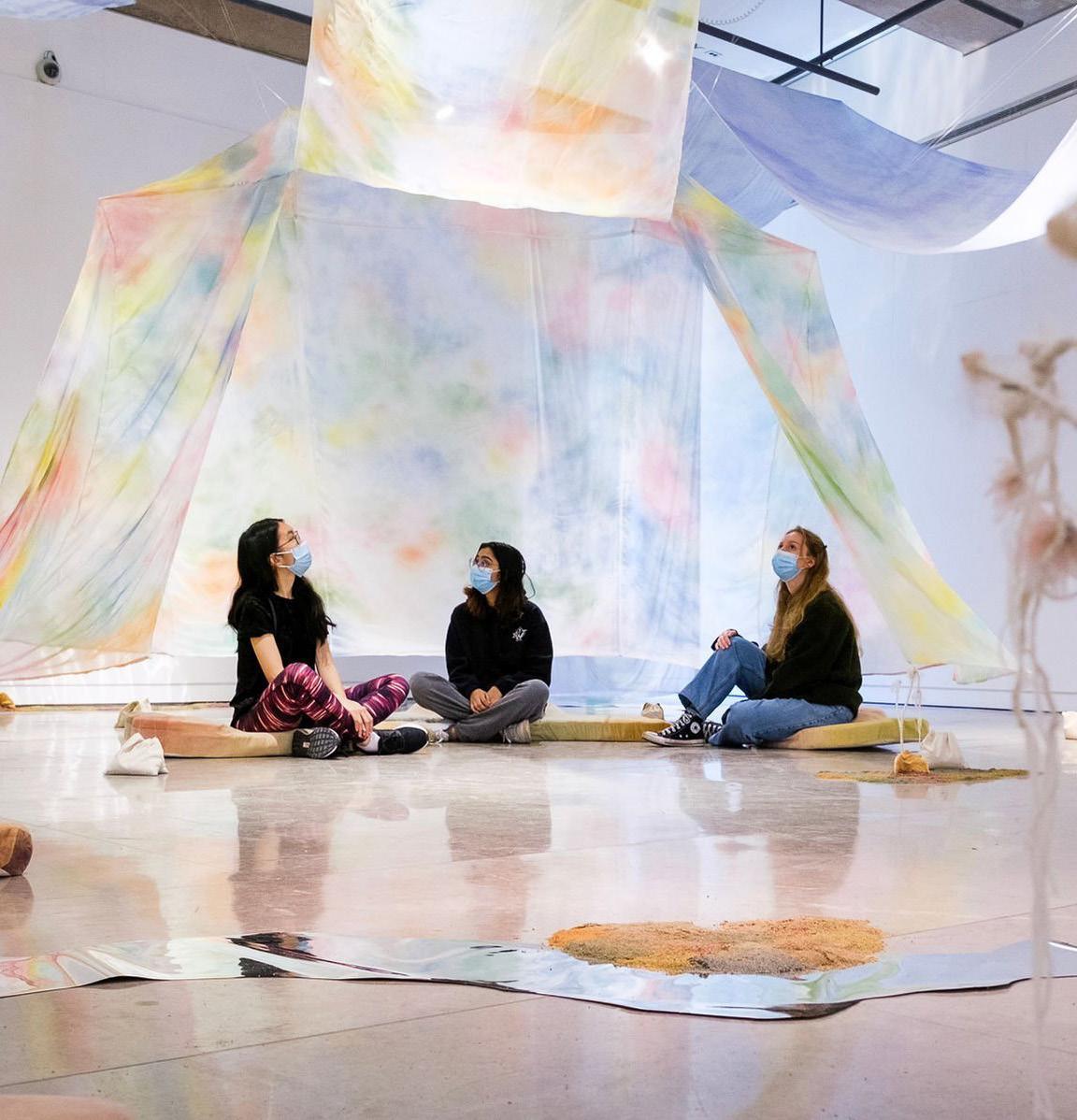
Essayh toes the lines between an effervescent sense of hope, the heart-breaking nature of grief and a self-proclaimed caution “to not over-romanticize [her] lived experiences.” During her residency at Ada X, she will use the physical spaces and equipment to craft
poetry that will serve as a song soundscape for The Evaporated Tears of Sand Roses, which will be exhibited at the Visual Arts Center of Clarington in Bowmanville, Ontario in February 2025.
“We cannot lose hope,” Essayh says. “We're not allowed to.”

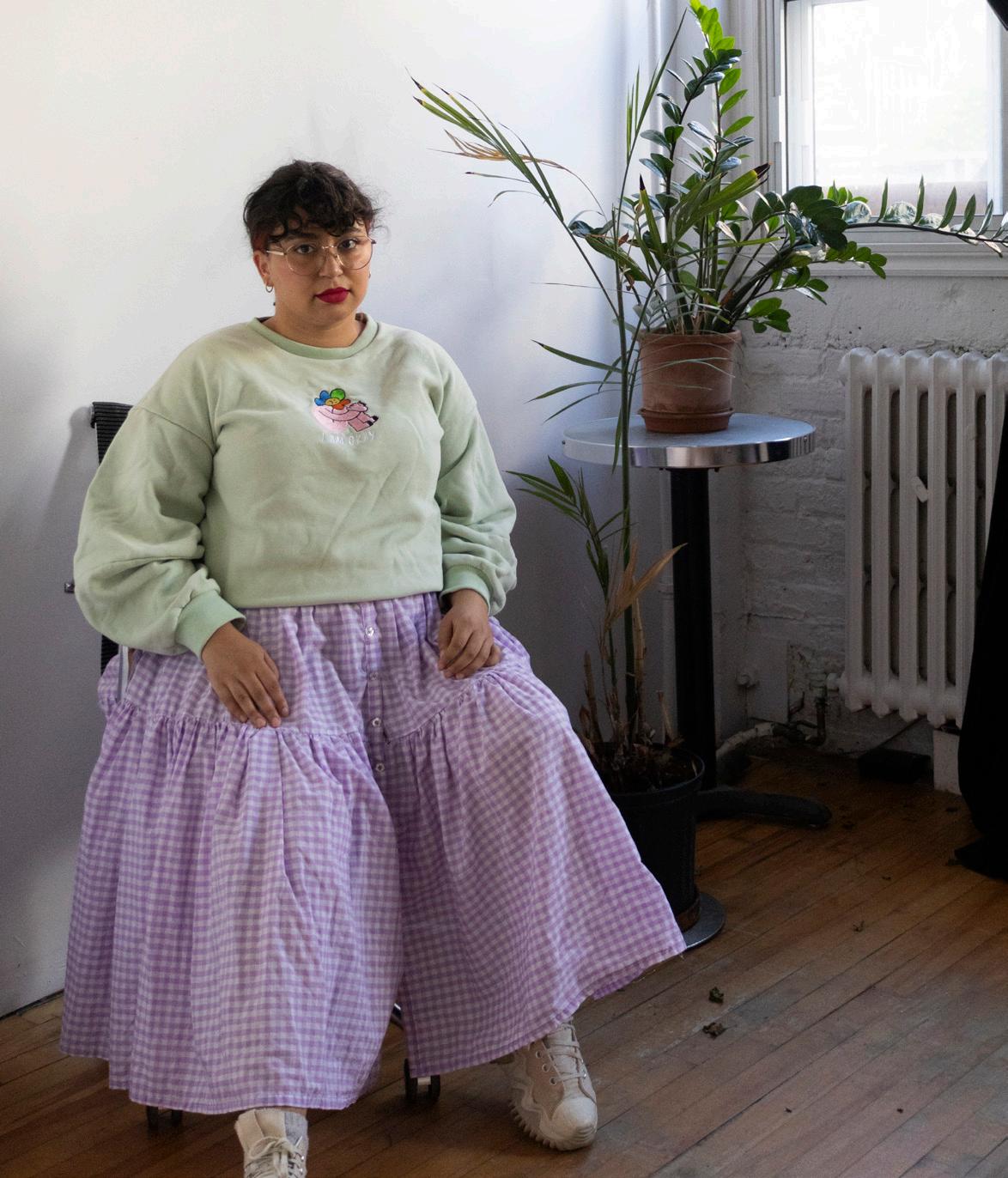

CSU collaborates with two students to host Orientation Week soccer tournament
Jared Lackman-Mincoff

@jared_lm02



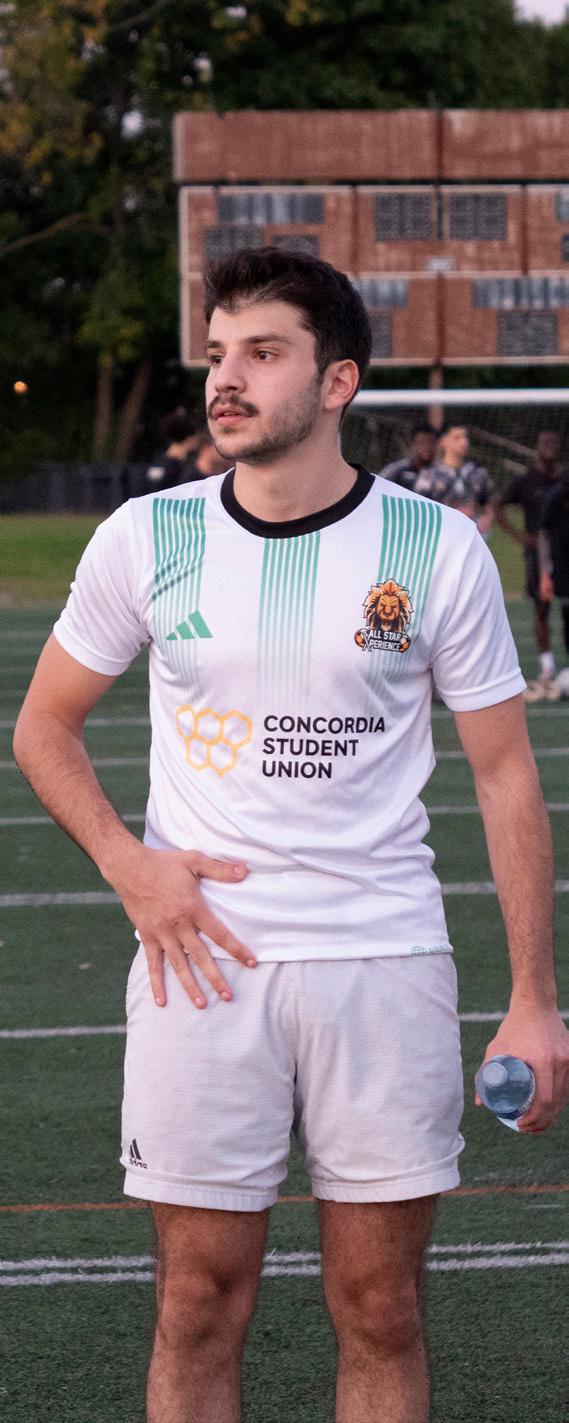

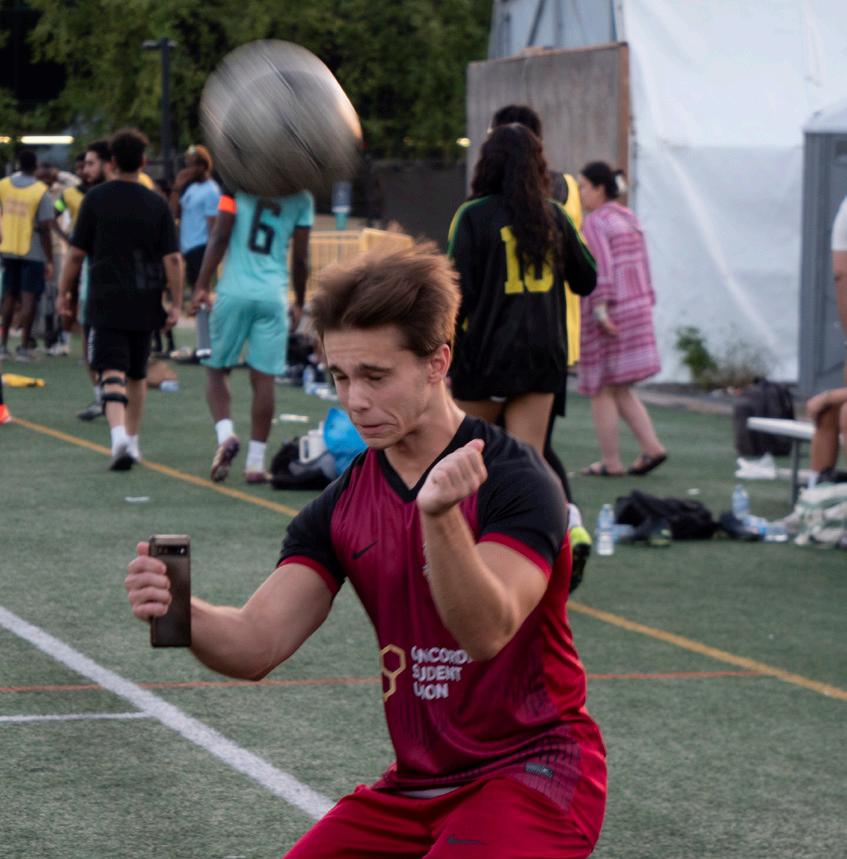

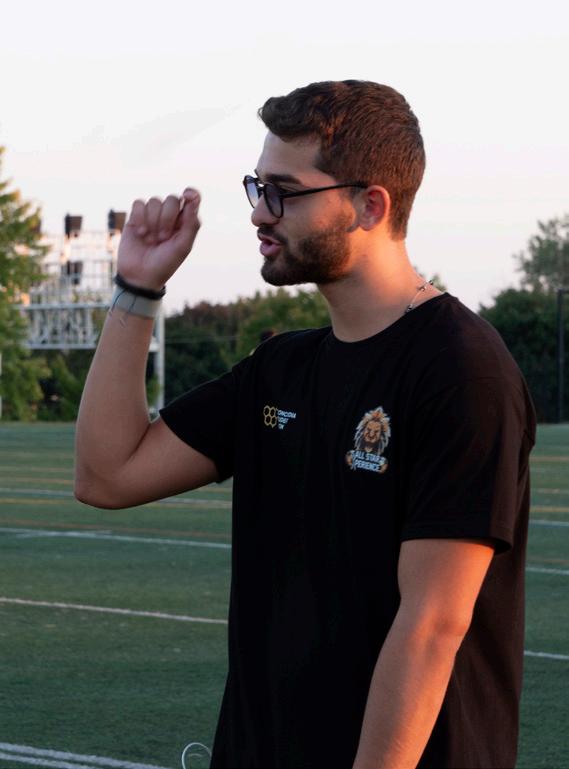
All Star Xperience (ASX), a soccer event company founded by two Concordia students, collaborated with the Concordia Student Union (CSU) to host a soccer tournament at the Loyola Campus. The tournament is part of Orientation Week for the Fall 2024 semester.
The two-day event was originally slated to take place on Saturday, Sept. 7 and Saturday, Sept. 14. However, due to heavy rain on Sept. 7, the tournament was pushed back to Sept. 14 and Friday, Sept. 20.

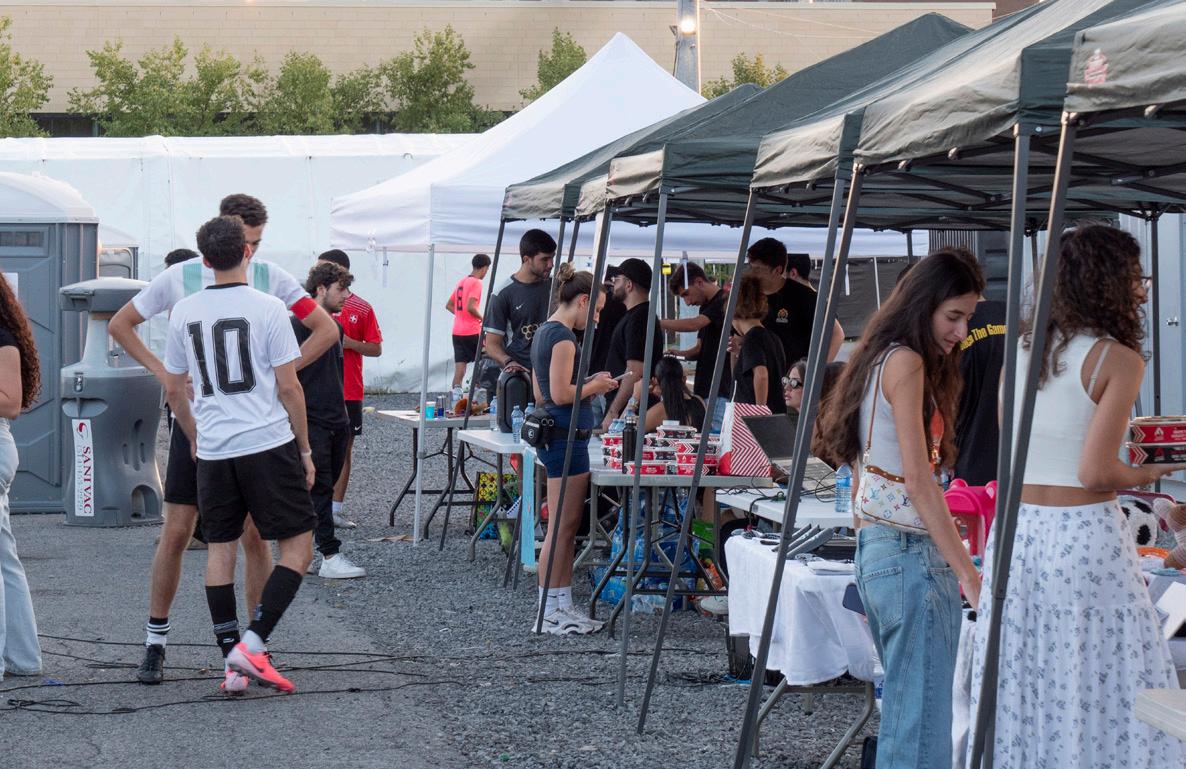

Jad Harb and Talal Selman foster the soccer community they wish they had with All
Jared Lackman-Mincoff

Jad Harb and Talal Selman may have had their dreams uprooted by circumstances outside their control, but nothing was going to keep the two soccer lovers down.
Originally from Beirut, they both started playing soccer from a young age. For Selman, the pitch became his home at four years old, and he began playing for his school teams as a defender. Harb played with his friends on the street, soon following suit and becoming a goalkeeper at school.
“Going into it, I started thinking more that I want to do this as a living,” Harb said.
Saad Balhawan coached Harb starting in first grade and all the way through various levels of the Lebanese national team. Balhawan believed that Harb had the dedication and skill set for a successful soccer career, being one of the best national team players he had ever seen.
“He has passion. He loves football too much,” Balhawan said.
Balhawan trusted Harb so much that, during one tournament match, he had Harb play as a striker when his team needed a goal, and had him retreat to goalkeeper when he wanted to preserve the result.
Harb and Selman often faced each other, playing for rival schools and club teams. Both got to know each other well, but their friendship only truly took off when they became teammates on the under-20 Lebanese national team.
After joining the national team, they quickly adopted a new routine that included several practices and games per week. They felt comfortable. It felt as if their dream of playing professional soccer was within reach.
But their world came crashing down when they least expected it. The 2019 Lebanese financial crisis, one of the worst in recorded history, dashed their dreams.
“Everyone's money got stuck in
the banks and a lot of people who had money woke up the next day and didn't have any more,” Selman said.
The COVID-19 pandemic and the Beirut port explosion in August 2020 only exacerbated this.
Harb and Selman were teenagers who, by their own admission, did not fully understand what was going on. But it became brutally clear once the crisis altered their life paths.
“One day, I wake up, and my father tells me, ‘Listen, you’re not going to do your undergrad here. It’s too unstable. We don’t know what’s going to happen the next day,’” Selman said.
In the fall of 2021, Montreal became their new home. Currently, they are in their fourth year of industrial engineering at Concordia University. Sticking closely together, both share the same courses and assignments.
“If you go to any of our lectures,” Harb said, “you’ll see us sitting right beside each other, just talking about school or business.”
After arriving in Montreal, they were eager to keep soccer alive in their daily lives. They entered several tournaments and small leagues until they found teams that would take them in.
Selman began playing in 2023 for Mont-Royal Outremont, a semi-professional club in Quebec’s Ligue 1. Harb suited up in the same year for the Club de soccer Montréal Centre in the Ligue de soccer élite du Québec, one tier below Ligue 1.
With these new teams, they were able to keep doing what they loved most. However, they found it hard to find a sense of community within their respective roles.
“We noticed that there was something missing,” Harb said. “We went into many tournaments here and leagues where you just go, pay the registration fee and then [organ-
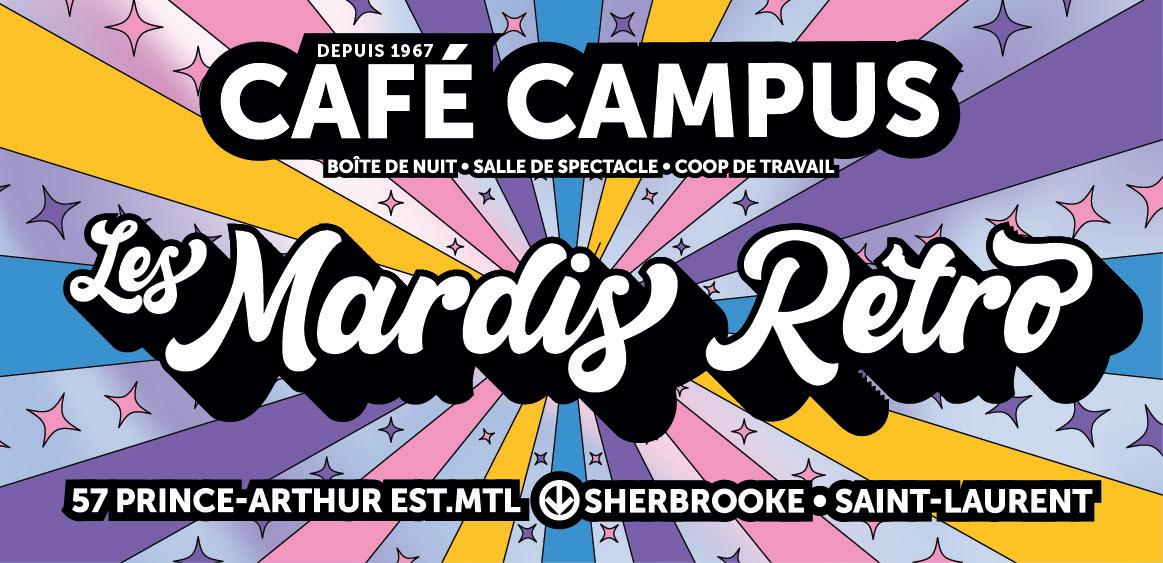
izers] don't really listen to you.”
It was glaringly obvious that they were completely on their own.
Many of their friends were not as lucky as they were. Several had come to Montreal and, despite looking for ways to continue playing soccer, drew the short straw and eventually gave up.
“They were just [quitting],” Selman said. “We felt like it shouldn't happen, and we should give them what they want.”
This is how All Star Xperience (ASX) came to be.
Harb and Selman founded the company in late 2023 with the goal of fostering a community of soccer players and giving newcomers more opportunities to continue on the pitch.
“The first couple of tournaments we did were short tournaments. So, one-day tournaments or two-day tournaments,” Selman said. “We were just doing them to put our name out there.”
Their first tournament had only eight teams, composed exclusively of friends of Harb and Selman. Over time, ASX grew. People they didn’t know began sending them messages asking about their tournaments. They also decided to give out cash prizes, not because it attracts more people, but as a way of giving back and showing appreciation to their participants.
“We really touch on the emotional side of the base where we love our players,” Harb said. “And it's not only just about playing soccer, it's about building a whole community.”
The Concordia Student Union (CSU) reached out to the inseparable duo to set up the CSU All-Star Cup for Concordia students, as part of Orientation Week for the Fall 2024 semester. It is their biggest tournament yet, spanning two days with 20 teams and roughly 250 students participating.
Many who took part appreciate having an accessible tournament on campus.
“It’s a positive experience,” participating student Faysal Dandashli said. “It’s something that hasn’t really been done before. It’s a great way to meet others, connect with people.”
ASX is also putting on the 10-week ASX Premier League at Montreal’s Lower Canada College


“We went into many tournaments here and leagues where you just go, pay the registration fee and then [organizers] don't really listen to you.”
- Jad Harb, co-founder of ASX
starting in early October.
Both Harb and Selman are happy with their playing careers at the moment. Harb mentioned that receiving a semi-professional contract would be a nice milestone to achieve, but he remains content with his current position.
The only thing truly missing from their sporting careers is donning the Concordia Stingers maroon and gold in their final two
years of study.
“We played at elementary, middle school, high school level with all the teams,” Harb said. “It’s nice to represent our university.”
On the business side, they hope to grow ASX and host tournaments across Canada, perhaps even worldwide eventually.
“Soccer is the worldwide language of sports,” Harb said. “It should be open for everyone.”


Jared Lackman-Mincoff

@jared_lm02
The Vanier Cup, the annual U Sports football championship, has been steadily declining in attendance over the past decade.
The official attendance of 7,109 for the 2023 edition falls short of the perennial crowds of 20,000 in the early 2010s, which included a record showing of 37,098 in 2012. It is the lowest attendance since the COVID-19-restricted crowd of 5,840 in 2021.
Moreover, the 2024 Canadian Football League (CFL) draft saw only 47 U Sports players selected out of 74 picks. The U Sports selection comprised roughly 64 per cent of the draft, the lowest since the 57 per cent proportion in 2021.
However, it hasn’t been all bad for U Sports football.
The low attendance and low TV ratings for the 2023 Vanier Cup can be attributed to the game being played in Kingston, Ontario between two teams from Montreal and Vancouver.
Despite both teams boasting considerable fan bases, fans were
likely unwilling to travel to attend the game, and simply had better ways to enjoy their weekend.
The increased cost of living has to be taken into consideration, as many Canadians, including myself, are cutting back on entertainment spending.
Regardless, game attendance is off to a hot start in 2024.
The Université Laval Rouge et Or football team set a new team attendance record when 20,903 enthusiasts witnessed their thrilling 23-22 victory over the Montreal Carabins on Sept. 7.
The Rouge et Or had the highest average attendance in all of U Sports in 2023 with 15,281 fans per game. It will always turn heads when the country’s most popular team breaks an attendance record.
In terms of draft prowess, U Sports may not have left as big a mark as it hoped at the CFL draft, but it certainly made a splash down south.
Giovanni Manu, offensive lineman for the University of British

fourth
National Football League
draft.
He became the first U Sports player to get selected in the NFL draft since David Onyemata of the University of Manitoba Bisons in 2016. He is unlikely to suit up for NFL games this year, but his development will be one to watch.
Another UBC offensive line-
man, Theo Benedet, went undrafted in the NFL, but immediately signed a contract with the Chicago Bears. U Sports did just fine in 2024 football drafts.
The next CFL draft could be an interesting one for Canadian university football. It has the potential to make headlines at a position where U Sports has been notoriously unsuccessful at producing professional players: quarterback.
The 2025 CFL draft may in-
clude several U Sports signal-callers: Jonathan Sénécal from Université de Montréal, Evan Hillock from Western University, Taylor Elgersma from Wilfrid Laurier University and Garrett Rooker from UBC, among others. University football’s success in Canada has always been cyclical. There is no reason to stress over slight declines in numbers. U Sports football will be back very soon. In fact, it never left.

Jared Lackman-Mincoff and Alice Martin

@jared_lm02

@_alcmrtn

Ottawa Charge Grade: D-
The name itself is fine, but it’s not strong enough to make up for the complete lack of reference to the city of Ottawa. The bland “C” logo is overdone. Making it more unique, perhaps by including the Ottawa River or Parliament Hill in some capacity, would have bumped up its grade.
Toronto Sceptres Grade: D
It was bold (in a bad way) to reference the monarchy in Toronto’s team name. Although we understand it’s a callback to the city’s wellknown Queen St., Toronto has so much more going for it than that. Also, if you have to include the definition of the name in the reveal, it’s probably a bad idea. D for disappointing.
Minnesota Frost Grade: B
Minnesota is definitely more than its cold weather, but it fares well on our list due to its decent logo and branding. Not to ruin the experience for you, but the wordmark is giving a low-budget Frozen knock-off. We love a reference to harsh weather as a reference to strength and power, but it feels overused and unoriginal.
New York Sirens Grade: B+
The name is a clever hat tip to New York City’s constant high energy. The reverberations of both S’s in “Sirens” are a nice touch. The “NY” shape recalls the city’s architecture, but it would have been more effective to reference a specific landmark or building, which NYC has in spades.
Boston Fleet
Grade: A-
Now we’re talking about a good identity. A fleet represents power in unity, while simultaneously being a great reference to the history and culture of Boston. The sideways anchor as a “B” for Boston with the wave pattern is an absolute win. While successful, it is a little simple.
Victoire de Montréal
Grade: A
With a fleur-de-lis in the middle, a reference to Nike, the Greek goddess of victory, an “M” for Montreal, and a name that works in English and French—the name and logo are near perfect. The only thing holding it back from A+ is the inevitable memes that will arise when the team endures a losing streak.


Yael Tobón Uribe @moonchildd02

I was recently discussing with a friend whether a certain word was grammatically correct for a sentence we were working on for an Instagram post.
She said, “I don’t actually care; I don’t respect this language enough to care.” I found her comment amusing, but it also led me to reflect on the topic of language more broadly. My friends often wonder how I managed to succeed in my English and creative writing program, given that I still struggle with certain English rules. I sometimes find myself questioning the same thing.
This weekend, I was invited to a Mexican Independence party, which we call 'Noche Mexicana'. When I arrived at my friend’s apartment, they welcomed me with open arms, dressed in beautiful traditional outfits and hairstyles. The night made me reflect on home and how I carry Mexico with me.
I moved to Montreal two and a half years ago, and while people often ask if I miss the food and my family (which I do), I also miss the language I use to express myself. Sometimes, I feel like I’m missing parts of myself due to linguistic barriers that are hard to overcome. I always like to remind people how much funnier I am in Spanish and how frustrating it is that some of my friends will never get to see that side of me.
One of my personal biggest challenges when it comes to language is reading and writing. Due to ADHD, my struggle with reading is omnipresent, even in Spanish. Complex texts in university present a significant challenge, but they also make me proud of my ability to focus and successfully engage with the material. Despite this, writing remains a different story. I was born and raised in Mexico, so before university, I wrote mainly in Spanish. English and serious writing have always been intertwined in my mind. However, my English poetry often feels somewhat alienated from my true self, due to language differences and the unique cultural context of my Mexican background.
I’m used to writing in English for essays and poetry. After the semester ends, I’m always surprised to find myself still thinking in English. I forget words in
my mother tongue when talking to my parents on the phone. They tease me, and the term 'malinchista' comes to mind.
According to mexperience, 'Malinchista' is a term some Mexicans use to describe other “Mexicans who show a preference for foreign things, speak gushingly of the order and tidiness to be found abroad, or are critical of Mexico and Mexican ways vis-à-vis their foreign counterparts.” I’m always a bit embarrassed to admit that I write mostly in English, but my family and friends in Mexico understand that my audience is primarily anglophone in the current cultural context. I’m deeply grateful for the chance to weave Mexican context and rich Spanish vocabulary into my English poetry. Last month, I wrote my first serious poem in Spanish for a Latin American anthology, and it was accepted. Although I was excited, it took me about a week to recover from the emotional impact. The poem was about my recent breakup—despite writing over five English poems on the same topic, this one in Spanish affected me the most.
I recently read an English trans-
lation of the poem Hombres Necios by Sor Juana Inés de la Cruz. Some translations use words such as silly or foolish for the original Spanish 'necios', a nuance that might be lost on non-Spanish speakers, and significantly changes the poem's impact. 'Necio' is a term I grew up hearing, describing an ignorant person who lacks intelligence or reason and is stubborn. Thus, translating “Hombres necios que acusáis a la mujer sin razón” as “You foolish men who lay the guilt on women” doesn’t capture the full essence of the original text. Despite these hurdles, I strive to preserve the core of my mother tongue in my poetry. My poem Mi Niña Hermosa, set to be published in Augur Magazine later this month, includes Spanish phrases that carry unique emotional weight. The title, Mi niña hermosa, is a term of endearment my mom uses, which doesn’t carry the same emotional meaning when translated to English as “my beautiful child.” Another Spanish term in the same poem is 'tianguis', referring to a traditional open-air market. In English, “street market” or “bazaar” might be used, but they lack the cultural depth of 'tianguis'
“Language becomes a barrier that I sometimes use to protect my work, creating a special connection with my people and maintaining the integrity of my art.”
making its translation feel almost inadequate. Writing in English for an anglophone audience also implies that the cultural issues I address can be easily overlooked. For instance, I recently wrote a poem about death and femicide in Mexico, honouring the lives of women like Debanhi Susana Escobar Bazaldúa, Adriana Fernanda López, 9-year-old Michelle, and Susana Rojas—cases that have profoundly impacted Mexican society. Their stories deserve recognition
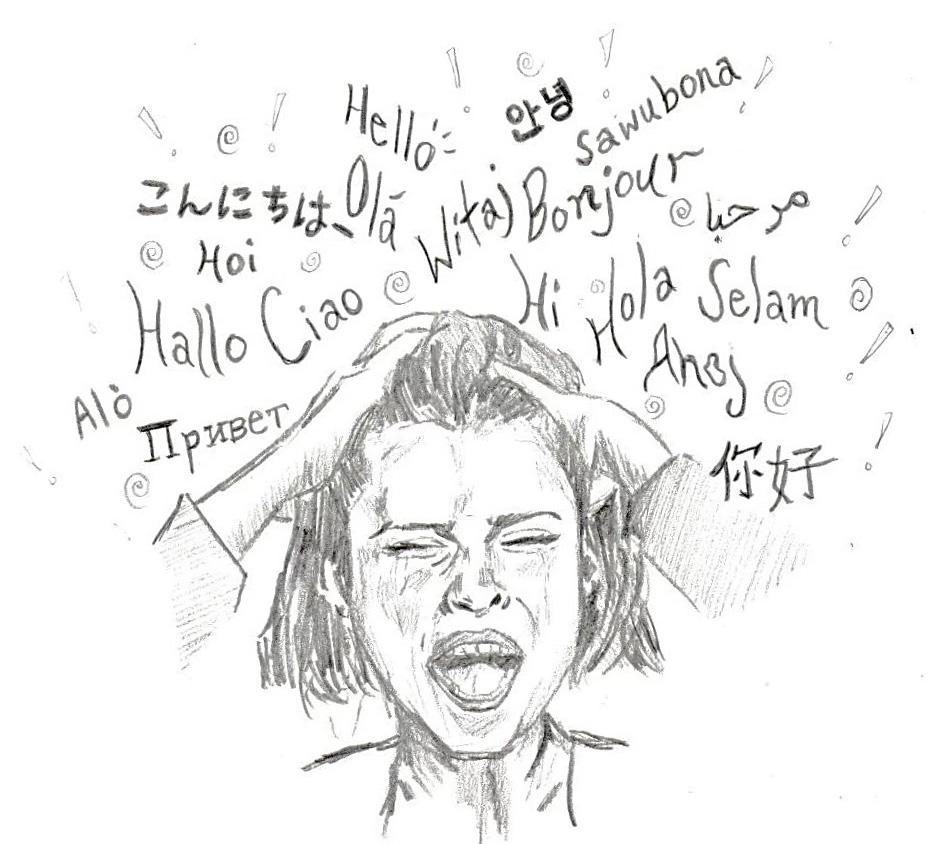
and should reach beyond national borders. Unfortunately, readers outside this context might not engage with these names or understand the media coverage and violent cultural background that Mexican women face.
Language becomes a barrier that I sometimes use to protect my work, creating a special connection with my people and maintaining the integrity of my art. I wouldn’t change anything about my current life and the environment in which I nurture my writing. My primary goal is to continually evolve and enhance my craft.
Writing in a different language has not only broadened my horizons but has also created valuable opportunities to connect with like-minded individuals, including fellow Mexicans. It has allowed me to share my unique background with a diverse audience, and I am heartened by the positive reception and appreciation for these cultural insights. Through these connections, I aim to bridge cultural gaps and offer readers a richer, more nuanced perspective. As I continue on this journey, I am motivated by the prospect of growing both personally and professionally, and by the hope that my work will resonate and inspire those who engage with it.


Claudia Beaudoin @claudiaclx

If you’ve ever felt ashamed of something trivial you've done in the past, or felt as if the whole world was against you, remember—even the worst kinds of people have their supporters.
From notorious criminals to murderers, everyone has fans.
The obsession with true crime is real, and it has only grown in popularity over the past few years.
YouTube is filled with creators who casually discuss the most gruesome murder cases while doing their makeup—blush, torture, lipstick shade, cause of death. Does it sound insensitive? It just might be.
While this trend has died down somewhat due to growing criticism over the lack of sensitivity toward victims' families, it doesn’t change the fact that the true crime genre continues to profit from these horrific cases—often cutting corners to maximize gains.

An example is Netflix's Jeffrey Dahmer documentary. Many victims' families weren’t informed about the documentary’s release until after it aired and were traumatized reliving the events. Not mentioning that it wasn’t the first time a retelling of this case had been released as a series.
More recently, Netflix's May December, a fictional movie involving a teacher who preyed on a young boy, sparked controversy for its strong resemblance to a real-life case. The film, which came out in 2023 and gained traction in 2024, drew criticism from real-life victim Vili Fualaau. Fualaau expressed his frustration with the media for not reaching out despite the story closely resembling his own.
Big corporations do this all the time, but what does that say about the audience? Who are they catering to?
Why are we so obsessed with true crime? What is this fascination with the violence? I’m not here to conduct my own scientific research,
but from what others suggest, our fascination seems to stem from an evolutionary instinct. We seek out the details of such horrors as a way to better protect ourselves and those around us. We’re driven by a desire to understand the motives of these individuals and how such events unfold; knowledge is power.
It turns out there's even a term for people who fawn over criminals like Ted Bundy: hybristophilia, which describes an attraction to individuals who have committed heinous crimes.
Another theory suggests it may be the ability to control our fear in a safe environment. Experiencing the intense emotions that come with each new episode of our favourite podcast can be incredibly appealing, perhaps even a little addictive.
Yet, I still can’t justify the popularity of these stories. Sure, I indulge in celebrity drama or other cases to get that rush of adrenaline, but becoming desensitized to the point
where you find comfort in listening to horrors just doesn’t feel right.
Fictional books and movies exist for a reason, but when it comes to real-life stories with real victims, is it appropriate to use these as entertainment? Where do we draw the line?
Additionally, murderers often get more media attention than their victims, overshadowing the true impact of these tragedies. A recent study in the Proceedings of the National Academy of Sciences journal looked at 189 mass shootings in the U.S. over the past two decades. Researchers found that many of these attacks were carried out with the goal of gaining fame.
Unfortunately, there still is not enough research conducted on the subject matter to explain the exact cause of this true crime obsession. It gets harder to define the line between awareness and sensationalism.
Normalizing or even romanticizing atrocities certainly won’t bring peace to anyone, not even yourself.


Yael Tobón Uribe @moonchildd02
I got into K-pop four years ago, but over time, I’ve distanced myself from the industry.
Nowadays, I occasionally listen to K-pop music and follow idols on Instagram, but I no longer engage with the fandom the way I used to.
K-pop idols may appear cute, funny and shy in front of the camera, but their public personas are often manufactured. Their companies heavily monitor and control their behaviour, whether online or in person. Not to mention, they lack agency over their music and public image.
Through my interactions with other K-pop fans in the past, I’ve noticed them leaving heartfelt birthday messages for their favourite idols. Fans thanking idols for being a source of light and support during tough times is common practice, with some going as far as claiming idols have saved their lives. Fans can also win video calls with idols, which reinforces parasocial relationships and creates the essential illusion that stars genuinely care about individual fans.
It is also strengthened by multiple apps K-pop idols use to “com-
municate” with their fans—sending messages wishing fans a good day, updating them on their lives, asking if they’ve eaten and telling the fan base how important they are for the idol. Additionally, idols never fail to thank their fandom when winning a prize and proclaim that they are the reason they do what they do. Groups like TOMORROW X TOGETHER even have a song dedicated to their fans.
K-pop relies heavily on feeding the fantasy that there might be a chance for a personal connection with artists. I am reminded of Jean Baudrillard’s theory on hyperreality: the simulation is incredibly immersive, even more so than reality, and we’re loving it. Falling into this simulation is easy for younger minds, but it becomes problematic when this fantasy overshadows reality as we age, clouding our perception of the real world.
The term “idol” itself seems odd, especially considering the Cambridge Dictionary definition: “An idol is a person who is loved, admired, or respected a lot.” In K-pop, an idol’s success is often judged by
their perceived perfection in the public eye, which can be unsettling. The illusion is often broken and a scandal erupts if a K-pop idol is seen smoking, dating, wearing revealing clothing (for female idols) or drinking alcohol. These activities, which are often overlooked for Western celebrities, are forbidden in the K-pop realm—forbidden, of course, only in front of the camera.
Last year, idol, fashion designer and professor G-DRAGON was accused of using drugs. The allegations persisted despite his denial, and he had to voluntarily appear at a police station for questioning. G-DRAGON was ultimately exonerated of the charges, highlighting how even unfounded accusations can tarnish an artist’s public image. This incident exemplifies the precarious balance celebrities must maintain, as they often face scrutiny whether or not they are truly at fault.
However, it’s worth remembering that idols are not always as innocent as they may appear. It’s interesting to observe the discrepancy between the punishments idols receive when

prosecuted for alleged drug use, as seen in the case of G-DRAGON, and when they misuse their power to sexually abuse women. In 2019, a major scandal erupted in South Korea involving Lee Seung-hyun, a former member of the popular K-pop group BIGBANG. As the CEO of the club Burning Sun, Seung-hyun was implicated in a scandal involving prostitution, drug trafficking and police corruption. Initially sentenced to three years in prison, his sentence was eventually reduced to 18 months.
K-pop fosters parasocial relationships from its roots, allowing fans to grow a disproportionate attachment to idols. Given these incidents, it’s shocking to see that some fans continue to defend such idols and believe their favourites are exceptions to the industry’s patterns of behaviour. This piece is not meant to spoil anyone's enjoyment of K-pop but rather to express that K-pop idols are far from perfect. They are powerful individuals who may use their influence for nefarious purposes.


For over a year, the Concordia University Professional Employees Union (CUPEU) have been pushing for a better, hybrid work model.
On Sept. 4, the union officially began its strike, one day after it rejected a global offer from the university. The strike lasted seven days and was suspended on Sept. 12, after the university and union representatives reached an Agreement in Principle. The union will officially vote on whether to accept it on Sept. 18.
This strike, and CUPEU's demands, are about much more than just remote work—they represent the broader need for a university environment that is more fair and sustainable for all employees and students. CUPEU represents around 600 professional employees, including nurses, IT workers, academic advisors, financial analysts and guidance counsellors. These workers are the backbone of Concordia, ensuring that the institution functions smoothly and that students receive the support they need to succeed.
CUPEU’s strike proved to the university’s administration that, with a united front and direct action, people can create change. By pushing the union to go on strike and not listening to their demands, the university let both its employees and students down for seven days, backlogging access to services.
The Link commends the university for listening to its workers
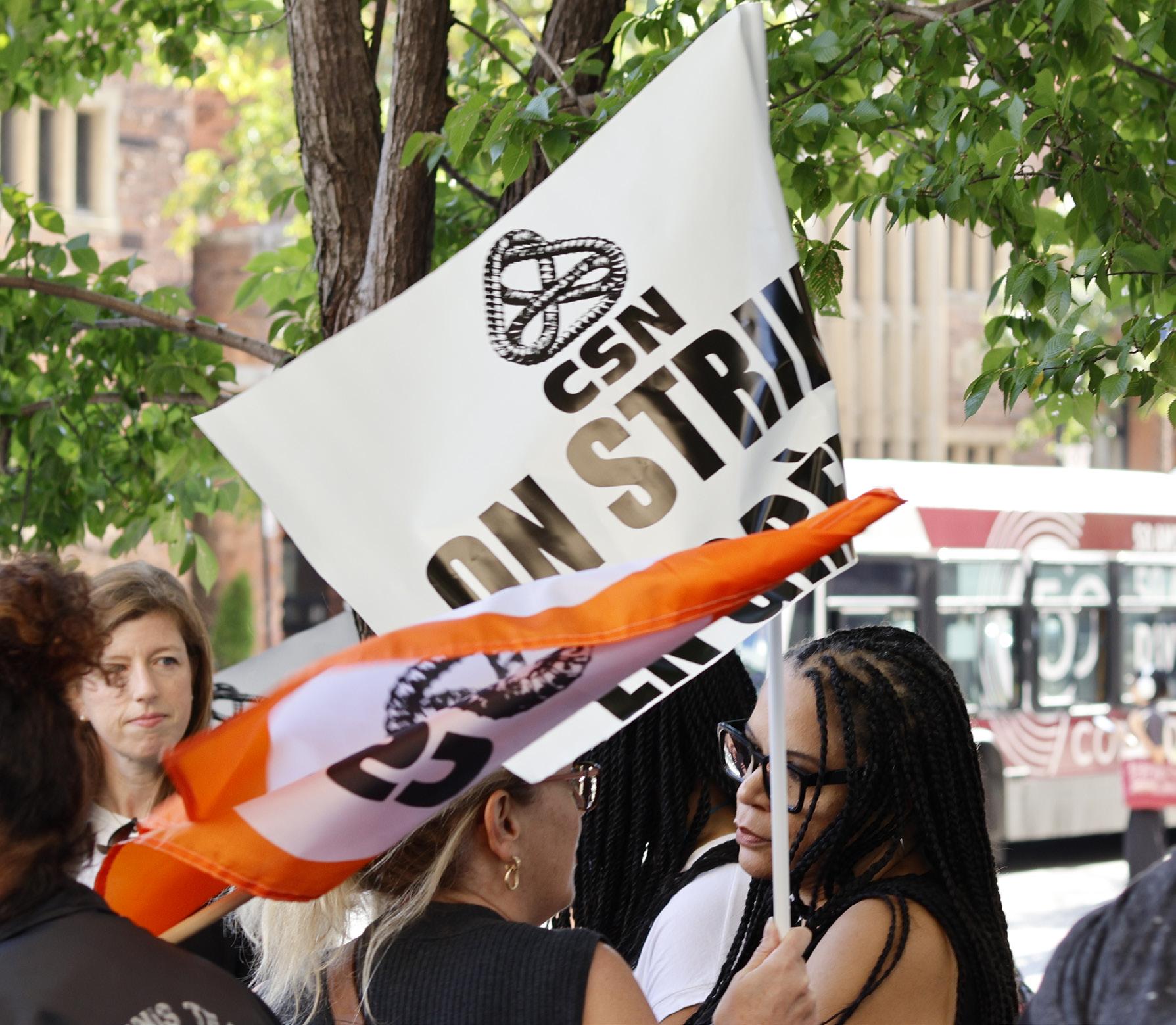
and hopes the agreement contains guidelines that meet CUPEU’s demands for a better work-fromhome system. While the administration's decision to reach an agreement is noteworthy, Concordia’s handling of the situation up to this point should not be ignored. Delaying fair negotiations for this long
brings forward a broader trend of institutional negligence toward workers' rights that we have seen time and time again from Concordia.
In September 2023, seven of Concordia’s workers’ unions gathered to demand fair pay and the preservation of the university's hybrid work model mandate after
the university blindsided workers by making them return to in-person work four days per week without prior consultation.
Workers were first made aware of these changes in an email sent to employees in June 2023.
Currently, Concordia only allows employees to work from home one day per week. Workers
across industries have adapted to hybrid models, and many now see it as a fundamental right, not just an option. Concordia’s refusal to meet this demand until pushed by CUPEU's strike reflects a concerning lack of understanding of the evolving needs of its workforce.
The university often promotes itself as a “next-generation” institution, one that values sustainability, innovation and inclusivity. However, CUPEU's struggle reveals a disconnect between these values and how the administration actually treats its workforce. How can Concordia truly call itself “next-gen” when it does not listen to the demands of its employees? A university's success depends not just on its reputation or academic output, but on the people who keep it running daily.
The repercussions of the strike have been felt across campus, with students experiencing disruptions in services. While these disruptions are unfortunate, it is critical that students understand that the cause of these delays lies not with CUPEU, but with Concordia’s refusal to negotiate fairly from the start. Blaming the workers for these delays ignores the fundamental issue: the administration's unwillingness to recognize and support the very people who make this institution function.
The Concordia administration needs to keep listening to the demands of its employees and students if it ever wants to reflect its “next-gen” motto.

Volume 45, Issue 2 Tuesday, September 17, 2024
Concordia University
Library Building, Room LB-717 1400 de Maisonneuve Blvd. W. Montreal, Quebec H3G 2V8
Editor: 514-848-2424 x. 7407
Arts: 514-848-2424 x. 5813
News: 514-848-2424 x. 8682
Business: 514-848-7406
Advertising: 514-848-7406
TheLinkis published twelve times during the academic year by TheLinkPublication Society Inc. Content is independent of the university and student associations (ECA, CASA, ASFA, FASA, CSU). Editorial policy is set by an elected board as provided for in TheLink’s constitution. Any student is welcome to work on TheLinkand become a voting member. Material appearing in TheLinkmay not be produced without prior written permission from TheLink . Letter to the editor are welcome. All letters 400 words or less will be printed, space permitting. The letters deadline is Friday at 4:00 p.m. TheLinkreserves the right to edit letters for clarity and length and refuse those deemed racist, sexist, homophobic, xenophobic, libellous or otherwise contrary to TheLink’s statement of principles.
BOARD OF DIRECTORS 2024-2025: Voting Members: Caroline Marsh, Jessica Hungate | Non-Voting Members: Hannah Vogan, Varda Nisar
TYPESETTING by TheLink PRINTING by Hebdo-Litho.
CONTRIBUTORS: Dexter Pahmer, Julia Cieri, Zosia, Jude M., Yael Tobón Uribe, Sara Salsabili, Sylvia Dai.
House Ads: Panos Michalakopoulos
Cover: Panos Michalakopoulos and Andraé Lerone Lewis
BEAUDOIN
DAS-BROWN
LACKMAN-MINCOFF LORY SAINT-FLEUR
LERONE LEWIS
DALDALIAN
OUAZZANI
HACHWA
























EVENTS EVERY WEEKEND KARAOKE COMEDY CHESS NIGHTS RAVES POP-UP
